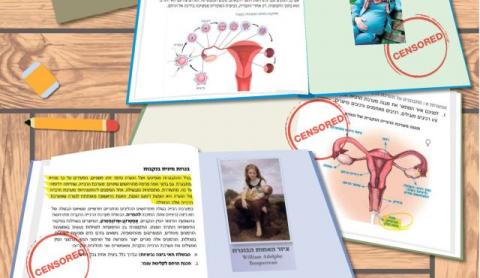Religious Israeli schools censoring human reproduction from textbooks
This will be the first time any distinction has been made between the science texts used in religious schools and those used in secular schools. Until now, all state schools, whether religious or secular, used the same science texts. Removing the chapter on reproduction means that at no point during their schooling will religious students learn about reproduction from a scientific standpoint, unless they take biology in high school. Every major textbook publisher in Israel confirmed the details of this report.
Currently, junior high school science texts have chapters on animal, vegetable and human reproduction. The human chapter includes pictures of the male and female reproductive systems and of a sperm fertilizing an egg, as well as explanations of the menstrual cycle.
According to the Education Ministry’s curriculum, the chapter “invites treatment of the issues of preventing pregnancy and preventing sexually transmitted diseases, with sensitivity and adjustments for the target audience.” This treatment is supposed to cover both “behavioral and technological methods” of prevention. Such preventive methods aren’t in the texts themselves; they are supposed to be taught orally by the teachers. Nevertheless, removing the human reproduction chapter from the texts means the issue won’t arise in class at all.
An examination of the chapters slated for removal reveals that they include basic scientific information about the reproductive system. For instance, one section describes the monthly menstrual cycle: “Every month (during the woman’s period of fertility) one of her ova (the egg cells) ripens and is released from the ovary where it was created. This stage is called ovulation ... Only if a sperm cell reaches the fallopian tube during those days will fertilization occur.”
The chapter includes pictures of the sperm approaching the egg, as well as illustrations of reproductive organs, like the ovary, uterus and fallopian tubes, but these organs are shown in isolation, unconnected to the rest of the body. There are almost no pictures of the human body, only illustrations, and even those, as noted, aren’t placed in the context of the entire body.
Last month, the ministry sent a letter to the publishers in which it asked them to send it a copy of each book before the changes, along with exact descriptions of “the pages and locations that must be removed.” A similar request was sent to the Weizmann Institute of Science, whose researchers write some of the textbooks. Weizmann’s publishing house originally agreed to make the alterations but later changed its mind.
One person involved in the issue said the decision is outrageous, because the ministry never formally decided to change the science curriculum. Academics involved in drafting the curriculum declined to comment. Science textbooks aren’t the only ones being altered for use in state religious schools, which have long had different history and literature curricula than the secular schools. About 18 months ago, the ministry decided to alter their Hebrew language textbooks as well. For instance, all women pictured in these texts now wear head coverings, and all the girls wear skirts.
Shmuel Shattah, executive director of the moderate religious Zionist organization Ne’emanei Torah Va’Avodah, blasted the decision to censor the science textbooks. “This was an opportunity for religious schools, during the school year and in a supervised fashion, to speak with students about very important matters, and it’s preferable for this to be done in the schools, by educators, rather than outside the schools, in places one shouldn’t learn such things from,” he said.
Shattah, who himself teaches seventh and eighth grade, said he brings in professionals to teach human reproduction and give his students a chance to ask questions. “The attitude was, it’s better for them to hear this from us and not get information only from the Internet or unsupervised sources,” he said. “After all, children will be exposed to the world at some stage, and then one possibility is that it will blow up in their faces and they won’t be able to cope with it as religious people,” he continued. “As a religious person, it’s better to inoculate them and teach them the reality of the world.”
The Education Ministry responded that women will still figure in the textbooks, but the chapter on human reproduction and methods of preventing it was removed because it doesn’t accord with the state religious school system’s educational doctrine for junior high schools.
Lior Dattel and Yarden Skop

